Model Context Protocol (MCP) - provided by Antrophic
논문 정보
- Date: 2025-04-15
- Reviewer: 준원 장
1. What is MCP
MCP가 왜 필요한가?
- Agent 논문 (Self-Reflection/React)를 보면 LLM이 api call/function call을 통해 response의 정확도를 높히곤 하는데, 여러 api call/function call와 통신하는데 있어 ‘규격화된 프로토콜’이 존재하지 않았음
⇒ 각 api마다 프로토콜을 개발해줘야했음 (예를 들어, 날씨검색을 위한 api call full pipeline을 api 제공자마다 설계해줘야 했음)
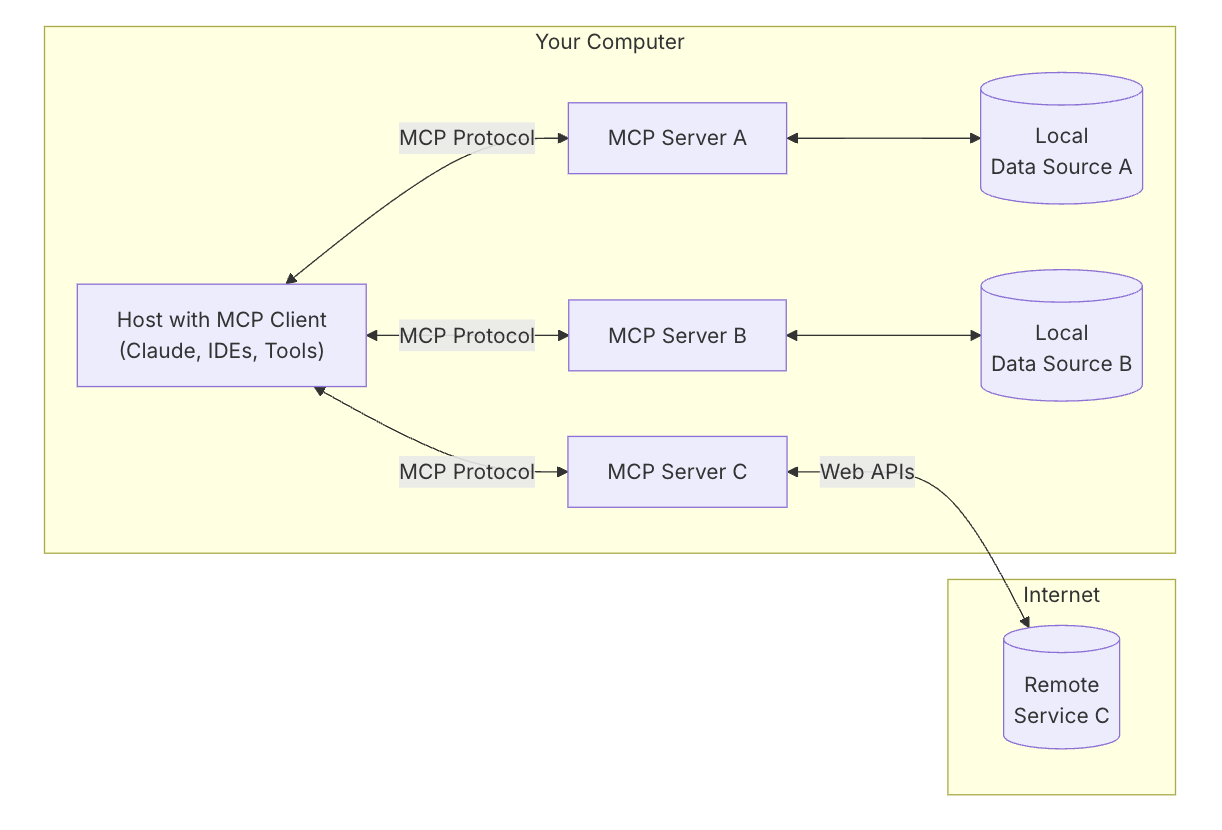
MCP란?
- Model Context Protocol(MCP)은 LLM(Large Language Model) 애플리케이션과 외부 데이터 소스 및 도구들 (api call/function call) 간의 원활한 통합을 가능하게 하는 개방형 프로토콜이다.
Protocol: 서로 다른 시스템 간 상호작용을 위해 정의된 규칙과 절차
⇒ api call/function call마다 개발하는걸 일종의 ‘abstraction’화 하여, LLM 사용자/개발자들에게 확장성을 키워줌
⇒ 여러 api call들을 제공하는 tool provider로 존재하는 github이 MCP server를 개발하면, LLM이 protocol에 맞게 통신만 해주면 손쉽게 api call하고 response를 받아 실행가능해짐!
-
MCP 구조는 아래와 같음
- MCP Hosts: Claude Desktop, IDE 또는 AI 도구와 같이 사용자가 직접 사용하는 프로그램. MCP를 통해 데이터에 접근하고자 하는 최종 사용자 애플리케이션.
⇒ 가장 상위 레벨의 어플리케이션으로 사용자가 prompt 날리는 대상 (Claude Desktop, Cursor)
- MCP Clients: 호스트 내부에서 서버와의 1:1 통신을 담당하는 기술적 구성요소. 프로토콜 규칙에 따라 메시지를 주고받는 통신 관리자 역할을 담당.
⇒ Host 내부에서 작동하는 구성 요소
- 메시지 변환 및 처리
- 프로토콜에 맞게 요청을 포맷팅
- 서버와의 통신 관리 (연결 유지, 오류 처리 등)
- MCP Servers: 특정 기능을 표준화된 Model Context Protocol을 통해 제공하는 경량 프로그램.
⇒ 각 서버는 특정 기능(api call/function call)이나 데이터 접근을 담당.
-
Local Data Sources (로컬 데이터 소스): 사용자 컴퓨터에 있는 파일, 데이터베이스, 서비스 등으로 MCP 서버가 안전하게 접근할 수 있는 정보 저장소 (
local database) -
Remote Services (원격 서비스): 인터넷을 통해 접근 가능한 외부 시스템(API 등)으로, MCP 서버가 연결하여 정보를 가져올 수 있는 외부 자원 (
web search results) -
MCP Protocol: 클라이언트와 서버 간의 표준화된 통신 방식으로, 데이터 형식, 요청/응답 구조, 오류 처리 등을 정의 (
pip install mcp로 설치되는 것)
MCP 통신 흐름
- 초기화 (Initialization)
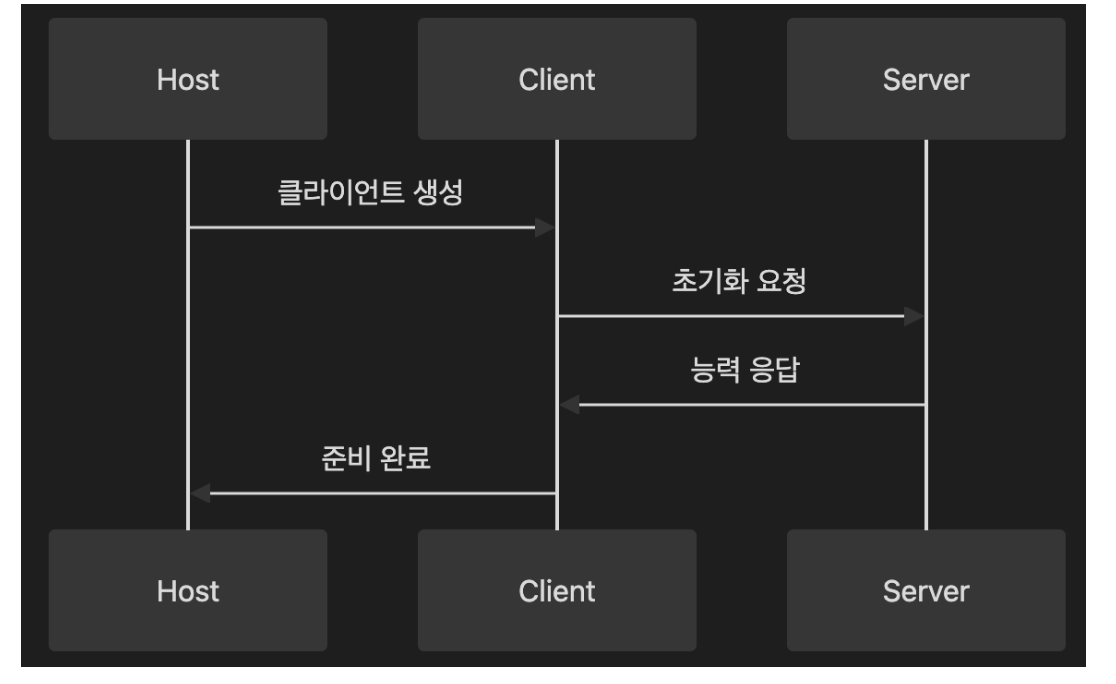
-
능력 협상 (Capability Negotiation)
-
버전 확인
-
서버 정보 교환
- 일반 통신
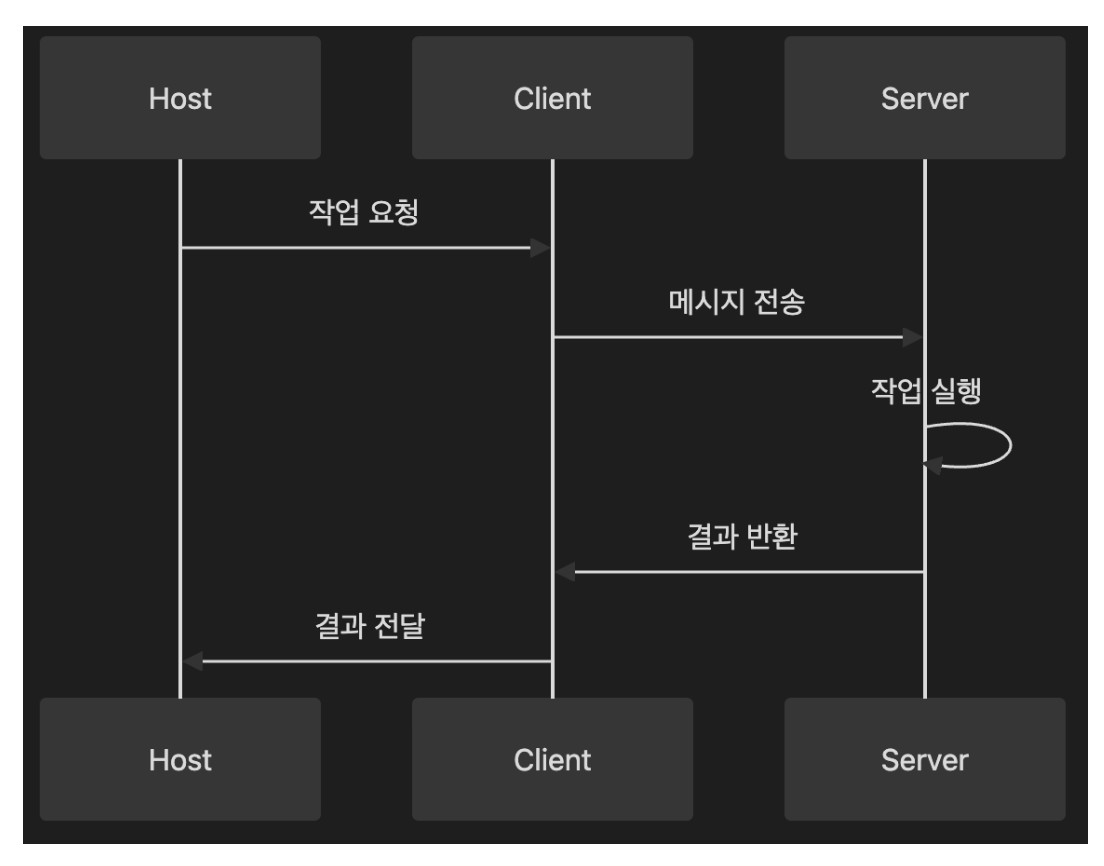
-
요청/응답 (Request/Response)
-
알림 (Notification)
-
에러 처리
- 종료
-
정상 종료
-
에러 복구
-
리소스 정리
-
Protocol까보면 사실상 client ↔ server는 json 구조로 통신함
// 기본 JSON-RPC 2.0 메시지 형식
interface JSONRPCMessage {
jsonrpc: "2.0";
id?: string | number; // 요청/응답 식별자
method?: string; // 메서드 이름
params?: object; // 매개변수
result?: object; // 응답 결과
error?: {
code: number;
message: string;
data?: unknown;
};
}
-
그렇다면 Model Context Protocol은 왜 각광을 받을까?
-
대 AI-Agent시대에 모델만으로 구현할 수 있는 action의 정교함에는 한계가 있고, 외부 툴을 활용하는건 어느정도 필연적.
-
**모듈성과 호환성의 압도적 향상**- 프로토콜에 맞게 개발된 모든 모델과 서버/도구는 서로 쉽게 교체가 가능해짐!
-
(LLM / MCP server의 자유로운 플러그인 아웃)

- USB 규격만 맞추면 어떤 USB 장치든 어떤 컴퓨터에도 연결할 수 있는 것처럼, Model Context Protocol을 따르는 모든 모델과 도구는 서로 원활하게 연결될 수 있음!
- 그만큼 보안을 보다 더 신경써서 client/server side를 개발해야한다고 함.
2. Practical Information
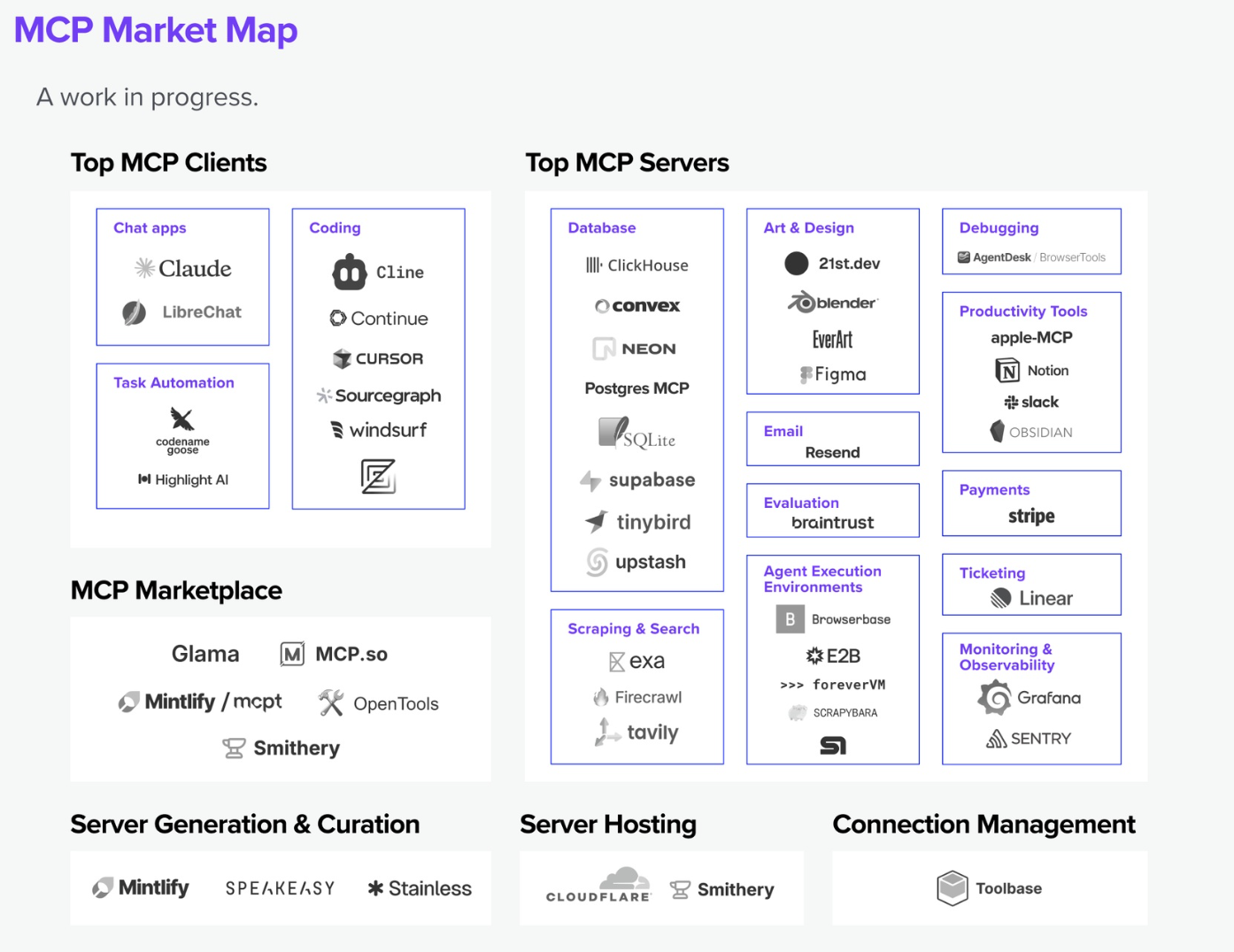
MCP Marketplace
→MCP client나 Server를 open src로 베포해놓는 platform
https://mcp.so/
https://smithery.ai/
MCP Client
⇒ claude가 어떻게 MCP로 server랑 통신할 것인가, 이런거를 정의해주는 건데
(이미 cursor등등에는 알아서 잘 정의가 되어있음)
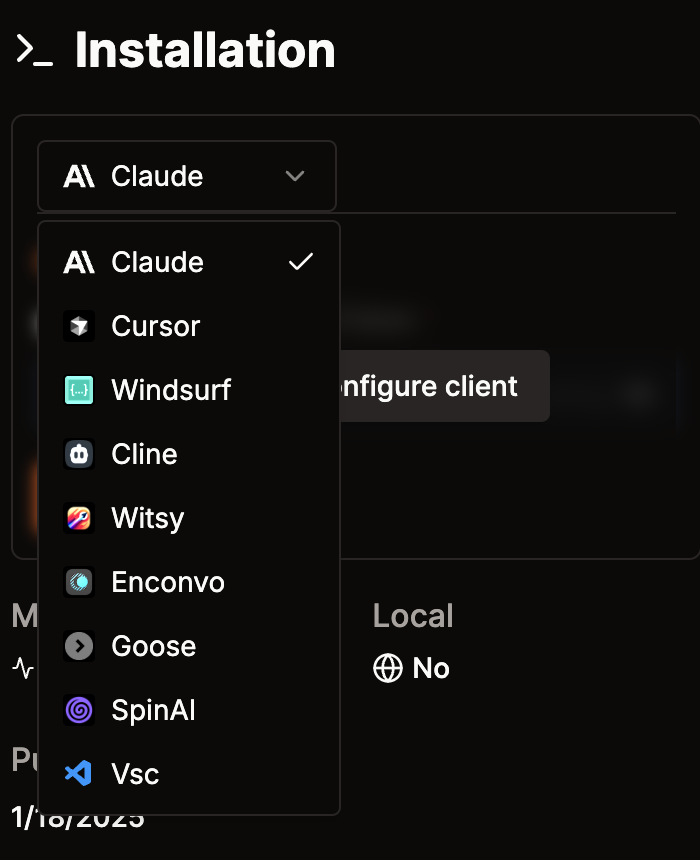
MCP Servers
⇒ 여러가지 tool들을 사용하게 해놓은 Server (MCP를 따름)
https://github.com/smithery-ai/reference-servers/tree/main/src/github
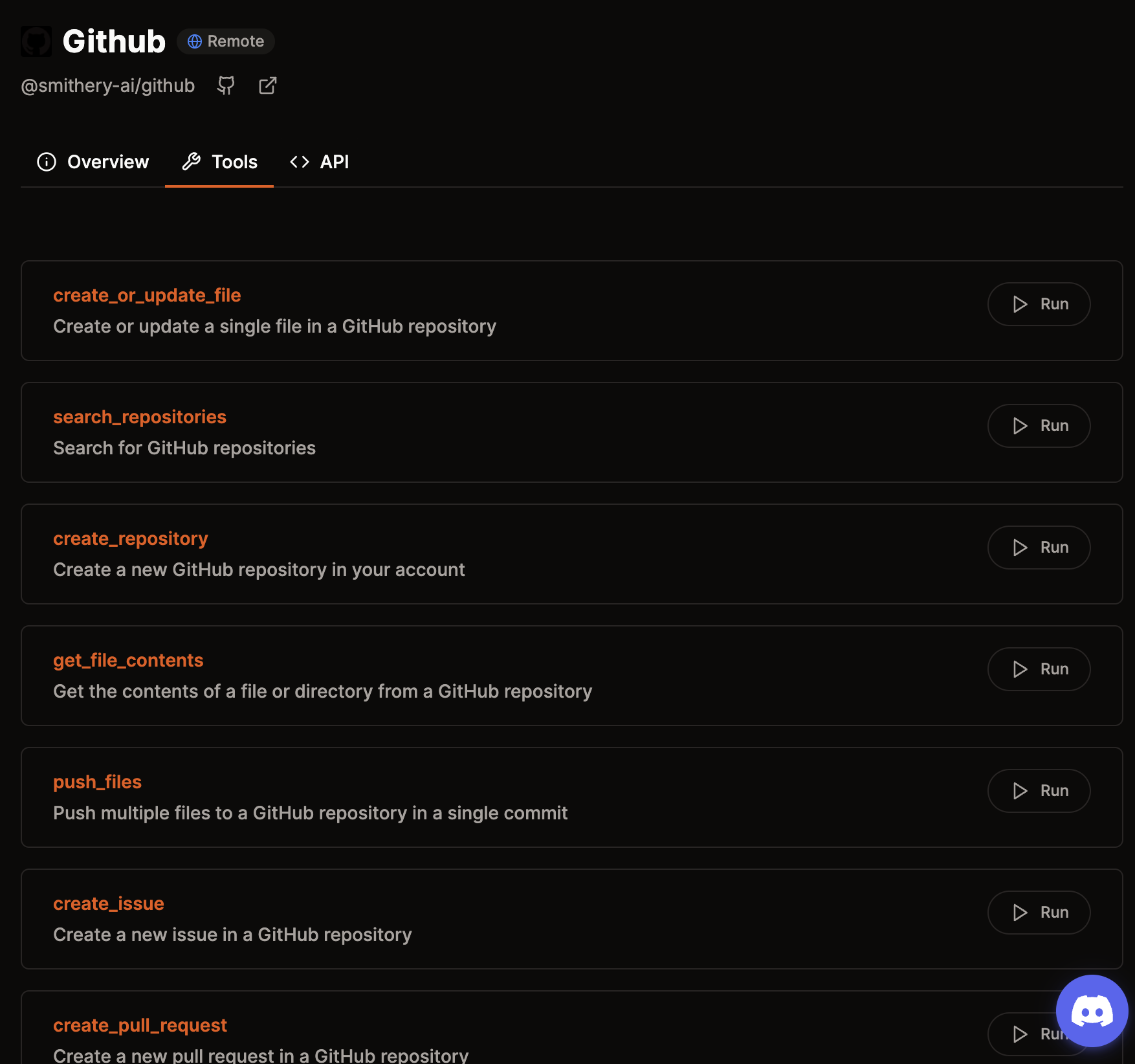
3. Examples
Cursor - Github MCP Server
- Github Token 발급 후 각 권한들 (Tool들)에 대한 권한 부여
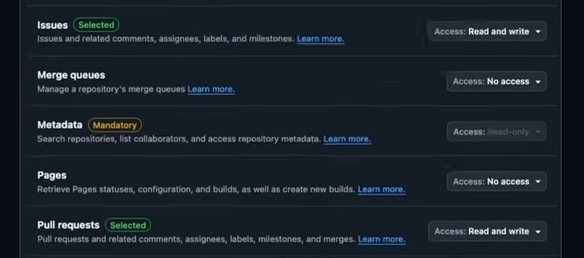
⇒ Issues & PR 권한 부여한 Token
- 1.에서 입력한 token을 기반으로 지정해준 MCP client에서 MCP server를 사용하기 위해 추가적인 configuration을 전달
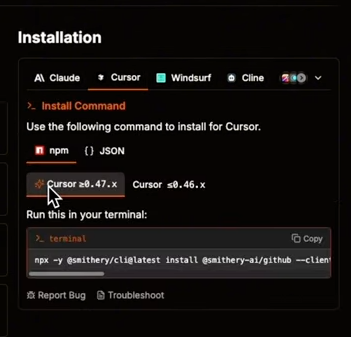
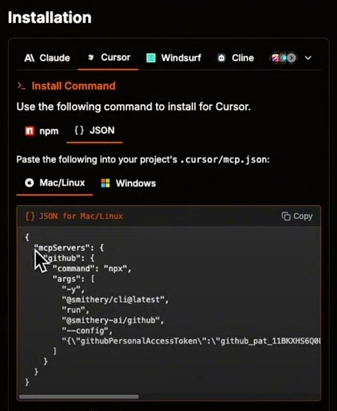
- Cursor > MCP > add to MCP > github json을 추가하면 아래와 같이 MCP server가 추가됨
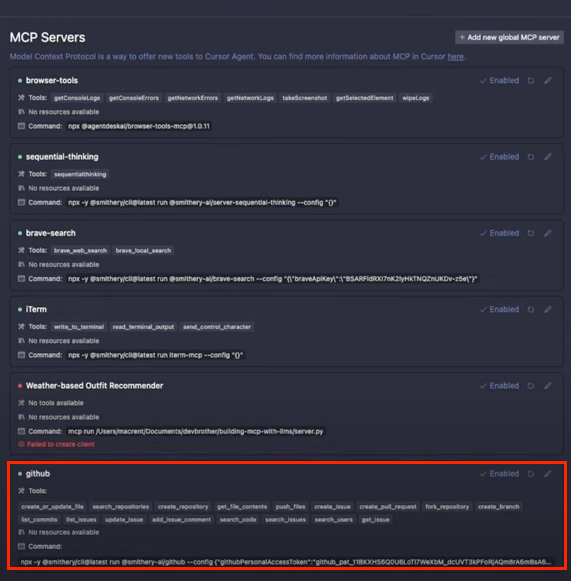
- Cursor (AI agent)에게 Github Token의 권한 아래 있는 repo에 대해서 tool 실행 (e.g., issue를 실행해줘)를 요청하면, (1) LLM이 특정 MCP server가 필요하다고 판단 → 특정 Tool 실행이 필요하다고 판단 (2) MCP에 맞는 입력 생성
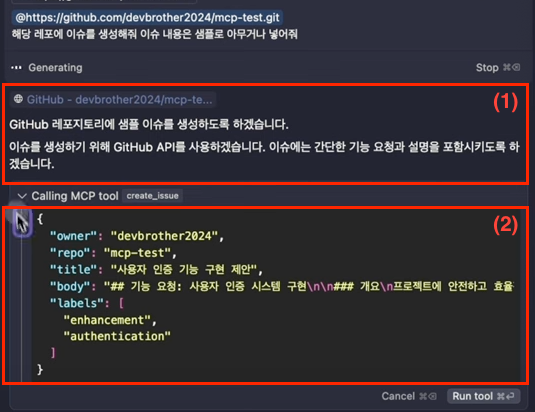
- Agent를 통해 성공적으로 Tool 실행 (
Run tool)
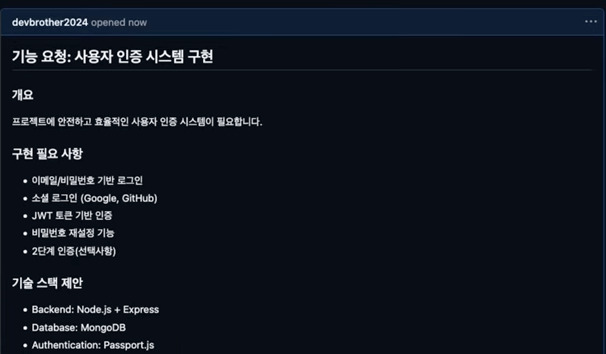
Cursor - Personal MCP Server (MCP Market Place에 내가 원하는 MCP Server가 없는 경우)
⇒ pip install mcp
- 수동으로 MCP Server 생성: https://modelcontextprotocol.io/quickstart/server
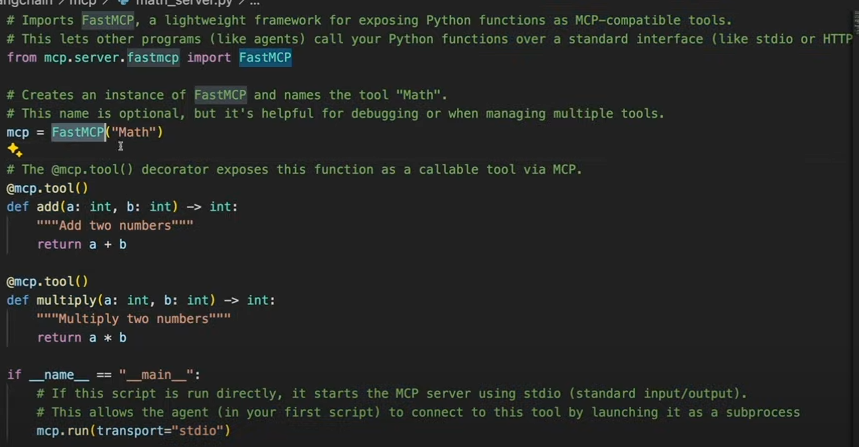
-
FactMCP 인스턴스 생성
-
decorator를 활용해
@mcp.tool()을 활용해 tool 정의 -
server가 independent하게 동작하는지 확인
if __name__ == "__main__":
# Initialize and run the server
mcp.run(transport='stdio')
- 서버의 경로를
mcp.json에 추가해주면 됨

- AI Agent (LLM)에게 prompt를 날리면 추가된 mcp server를 쓴다고 요청이 옴.
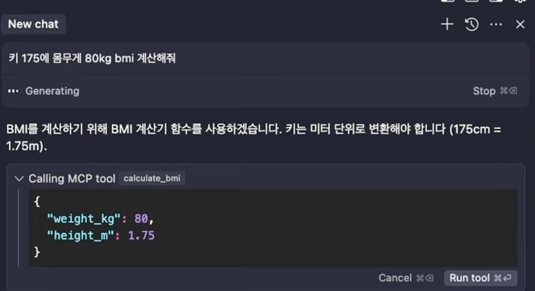
-
Run tool실행하면 tool 실행하고, 그 결과를 LLM result에 통합해서 최종 chat completion을 반환
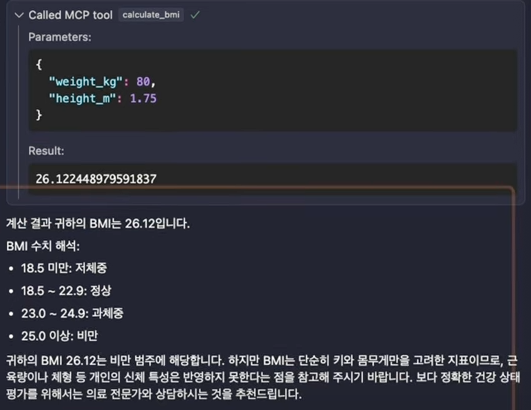
- LLM으로 MCP Server 생성: https://modelcontextprotocol.io/tutorials/building-mcp-with-llms
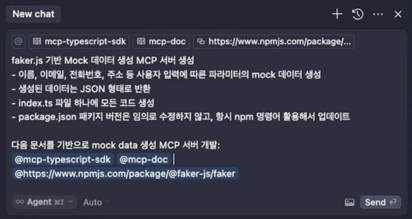
⇒ Example
-
https://modelcontextprotocol.io/llms-full.txt 사이트를 방문하여 전체 문서 내용을 복사
-
MCP TypeScript SDK 또는 Python SDK 저장소로 이동
SDK: 특정 플랫폼, 프레임워크 또는 시스템을 위한 개발 도구 모음
-
README 파일과 기타 관련 문서들을 복사 (e.g., mcp-python-sdk readme)
-
해당 문서를 이 문서들을 Claude(AI Agent)와의 대화창에 복붙
Cursor - Client Server
async def connect_to_server(self, server_script_path: str):
"""Connect to an MCP server
Args:
server_script_path: Path to the server script (.py or .js)
"""
is_python = server_script_path.endswith('.py')
is_js = server_script_path.endswith('.js')
if not (is_python or is_js):
raise ValueError("Server script must be a .py or .js file")
command = "python" if is_python else "node"
server_params = StdioServerParameters(
command=command,
args=[server_script_path],
env=None
)
stdio_transport = await self.exit_stack.enter_async_context(stdio_client(server_params))
self.stdio, self.write = stdio_transport
self.session = await self.exit_stack.enter_async_context(ClientSession(self.stdio, self.write))
await self.session.initialize()
# List available tools
response = await self.session.list_tools()
tools = response.tools
print("\nConnected to server with tools:", [tool.name for tool in tools])
-
MCP server 동작에 필요한 parameter를 준비하는 과정
-
MCP server initializer
-
MCP server내 tool들 load
async def process_query(self, query: str) -> str:
"""Process a query using Claude and available tools"""
messages = [
{
"role": "user",
"content": query
}
]
response = await self.session.list_tools()
available_tools = [{
"name": tool.name,
"description": tool.description,
"input_schema": tool.inputSchema
} for tool in response.tools]
# Initial Claude API call
response = self.anthropic.messages.create(
model="claude-3-5-sonnet-20241022",
max_tokens=1000,
messages=messages,
tools=available_tools
)
# Process response and handle tool calls
final_text = []
assistant_message_content = []
for content in response.content:
if content.type == 'text':
final_text.append(content.text)
assistant_message_content.append(content)
elif content.type == 'tool_use':
tool_name = content.name
tool_args = content.input
# Execute tool call
result = await self.session.call_tool(tool_name, tool_args)
final_text.append(f"[Calling tool {tool_name} with args {tool_args}]")
assistant_message_content.append(content)
messages.append({
"role": "assistant",
"content": assistant_message_content
})
messages.append({
"role": "user",
"content": [
{
"type": "tool_result",
"tool_use_id": content.id,
"content": result.content
}
]
})
# Get next response from Claude
response = self.anthropic.messages.create(
model="claude-3-5-sonnet-20241022",
max_tokens=1000,
messages=messages,
tools=available_tools
)
final_text.append(response.content[0].text)
return "\n".join(final_text)
⇒ tool results를 통합해 최종 chat completion를 도출
⇒ async 로 정의하는 이유?
-
비동기 프로그래밍을 위해
-
동시성 처리: 여러 작업을 동시에 처리할 수 있다. 한 작업이 I/O 작업(네트워크 요청, 파일 읽기 등)으로 대기하는 동안 다른 작업을 수행이 가능.
-
블로킹 방지: 서버가 한 클라이언트 요청을 처리하느라 다른 요청을 처리하지 못하는 상황을 방지
→ 여러 클라이언트를 타고 들어오는 요청이 엄청 많을텐데 비동기 처리를 해놔야 MCP 서버가 안정적으로 돌아감
4. Conclusion
-
MCP) 이전에 사용되던 여러 방식들에 비해 확실한 장점이 존재
-
커스텀 API 통합 (일회성 커넥터)
- 서비스마다 별도의 커스텀 코드나 SDK를 개발하는 방식 (AI가 Google Drive와 SQL 데이터베이스에 접근하려면 각각 다른 API와 데이터베이스 드라이버를 통합)
-
⇒ 제일 노동력 많음
-
언어 모델 플러그인 (OpenAI Plugins)
- 모델이 외부 API를 쉽게 호출할 수 있게 해주는 프레임워크
⇒ 대부분의 플러그인은 모델이 API를 호출할 형태를 만드는 방식에 초점
-
프레임워크 기반 도구 사용 (LangChain의 Tools, Agents)
- LLM에 “도구”를 설명하고 모델이 상황에 맞게 도구를 호출하는 방식
⇒ 개발자가 각 도구를 자신의 요구에 맞게 연결하거나 수정해야 함
→ MCP는 모델이 직접 관련된 도구를 발견하고 사용하는 프로토콜
→ 필요한 도구를 위해 에이전트 코드를 작성하지 않아도 모델이 MCP를 통해 해당 도구를 실시간으로 발견하고 사용 가능
→ MCP를 통해 data provider와 지속적인 양방향 통신이 가능
-
MCP가 사실상 Tool Usage의 표본으로 자리 잡아 가는중
-
앞으로 단기의 미래는 MCP Server내의 필요한 모든 기능을 Tool로 때려넣고 LLM Response에 통합시키는 방향으로 발전하지 않을까?
-
하지만, 미래에는 인간이 컴퓨터와의 I/O를 키보드&모니터로만 스마트폰과의 I/O를 화면&손가락으로 하지만 그 안의 수많은 tool들을 제어할 수 있듯이.. 궁극에는 가장 상위-level의 tool들만 남고, 나머지 기능들은 현재처럼 완전 세부적으로 호출을 요구하진 않지 않을까? (여러분의 생각이 궁금합니다!)
References
https://www.anthropic.com/news/model-context-protocol
https://modelcontextprotocol.io/introduction
https://wikidocs.net/book/17027
https://www.youtube.com/watch?v=zVSZ2gXvhVE
https://www.youtube.com/watch?v=0f3fTTXqTps
Model Context Protocol (MCP) - provided by Antrophic